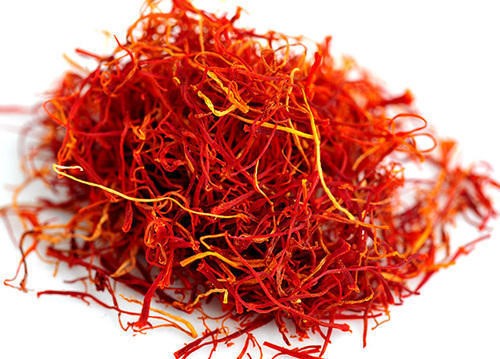SAFFORN BOWL PROJECT

Disclaimer: Copyright infringement not intended.
Context
- North East Centre for Technology Application and Reach (NECTAR) under Saffron Bowl project has identified few locations in Arunachal Pradesh and Meghalaya for saffron cultivation.
Saffron production
- Iran, India, Spain and Greece are the major saffron producing countries with Iran occupying the maximum area and contributing about 88% of world's saffron production.
- Though, India occupies the 2nd largest area but produces approximately 7 per cent of the total world production.
Kashmir saffron: The saffron Bowl
- Saffron Bowl: Saffron production has long been restricted to a limited geographical area in the Union territory of Jammu & Kashmir. Pampore region, in India, commonly known as Saffron bowl of Kashmir, is the main contributor to saffron production, followed by Budgam, Srinagar, and Kishtiwar districts.
- Origin: Saffron cultivation is believed to have been introduced in Kashmir by Central Asian immigrants around 1st Century BCE. In ancient Sanskrit literature, saffron is referred to as ‘bahukam’.
- Benefits: It rejuvenates health and is used in cosmetics and for medicinal purposes.
- Characteristics: The unique characteristics of Kashmir saffron are its longer and thicker stigmas, natural deep-red colour, high aroma, bitter flavour, chemical-free processing, and high quantity of crocin (colouring strength), safranal (flavour) and picrocrocin (bitterness). It is the only saffron in the world grown at an altitude of 1,600 m to 1,800 m AMSL (above mean sea level), which adds to its uniqueness and differentiates it from other saffron varieties available the world over.
- Recognition: Kashmir saffron, which is cultivated and harvested in the Karewa (highlands) of Jammu and Kashmir, got the Geographical Indication (GI) tag in 2020.
|
Types of Kashmir Saffron · The saffron available in Kashmir is of three types — · ‘Lachha Saffron’, with stigmas just separated from the flowers and dried without further processing; · ‘Mongra Saffron’, in which stigmas are detached from the flower, dried in the sun and processed traditionally; and ‘Guchhi Saffron’, which is the same as Lachha, except that the latter’s dried stigmas are packed loosely in air-tight containers while the former has stigmas joined together in a bundle tied with a cloth thread. |
NECTAR and expansion of the Saffron Bowl
- North East Centre for Technology Application and Reach (NECTAR) is an autonomous body under the Department of Science and Technology.
- NECTAR supported a pilot project to explore the feasibility of growing saffron in North East region of India, with the same quality and higher quantity as it is grown in Kashmir thereby expanding the Saffron Bowl Project.
- The Botany and Horticulture department of Sikkim Central University carried out tests to understand the soil and actual pH conditions of Yangyang of Sikkim and found it comparable to saffron growing places of Kashmir.
- The matching of climatic and geographical conditions between Pampore (Kashmir) and Yangyang (Sikkim) led to the successful sample farming of Saffron in Yangyang.
Further expansion
- Saffron Bowl project has recently identified few locations in Arunachal Pradesh and Meghalaya for saffron cultivation.
- Some sites have been identified in Meghalaya: Barapani, Cherrapunji, Mawsmai, Shillong, and Lalingtop.
|
National Saffron Mission About: The National Saffron Mission (NSM) was launched in 2010-11 for the cultivation of saffron in Jammu and Kashmir. Aim: The main objective of the scheme is to extend support for creation of irrigation facilities through tube wells and sprinklers which would help better crop in the area. Expansion: In 2020, the Government has decided to revive this mission and expand the cultivation of saffron to the north eastern part of the country. |
Boosting Saffron Exports
Recognition
- Kashmiri saffron had received the GI tag in July 2020 and this has boosted the domestic as well as the overseas business opportunities for Kashmir’s Saffron Market.
- With production declining and concerns of adulteration increasing, the prestigious GI tag is expected to restore saffron its earlier market size.
Holistic Steps
To further enhance the production of saffron a few things must be considered:
- Provision of good quality and high yield seeds.
- Extension in the area of cultivation and production.
- Extensive use of solar drier and air drier. Financial help for the purchase of these apparatus.
- Appropriate training for packing the produce.
Marketing
- Marketing is also one of the main problems. An average saffron grower finds it troublesome to sell the small quantity of his produce.
- The grading and packing individually is not highly profitable. The cultivator has scarce resources.
- So, this is necessary that cooperative societies are formed to sell the saffron at remunerative prices.
Final Thought
- A proper strategy must be devised and the whole activity must be so organized that the average saffron growers gets full benefits of his toils.
https://www.pib.gov.in/PressReleasePage.aspx?PRID=1794780



1.png)
